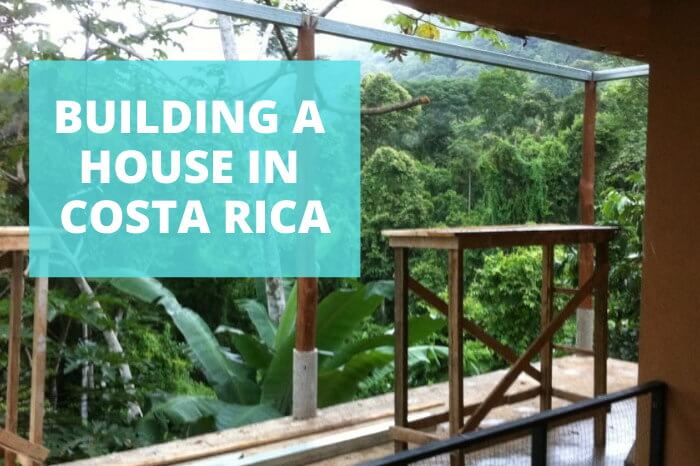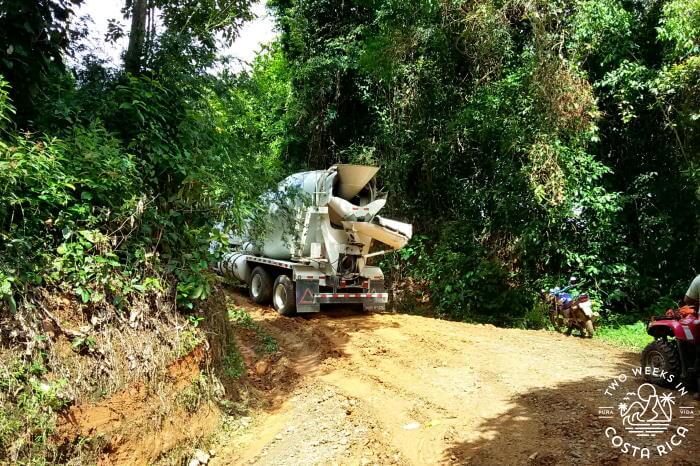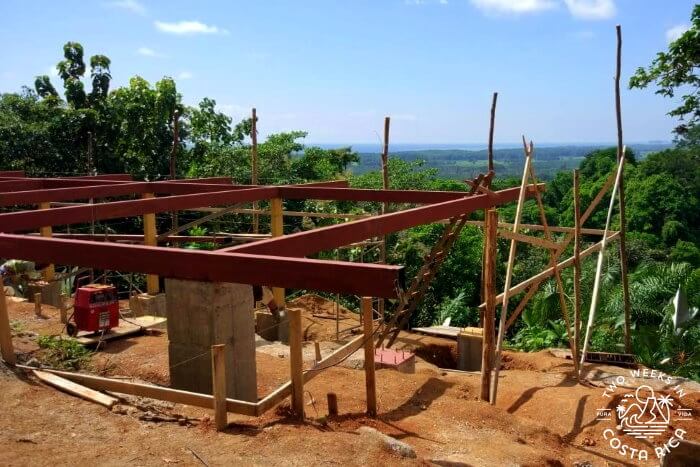With its warm weather, beautiful landscapes, and welcoming locals, Costa Rica is a desirable location for those moving or retiring abroad. For many people, building a house in Costa Rica is a top priority. A customized home gives you certain comforts, which you may not be able to find in a prebuilt house. Or maybe you are looking to invest and create a dreamy rental property that will bring in extra income in the future.
But where do you start when building a house in a foreign country like Costa Rica? What hurdles are there and how is the process different from what you may be used to? To get some answers, we sat down with an experienced contractor and longtime acquaintance. In this post, we’ll share his insights into building a house in Costa Rica.

Background – Building a House in Costa Rica
We have lived in Costa Rica for over seven years and have either done house sitting or rented the entire time. Over the years, we’ve lived in many different style homes and can see why someone would want to build their own custom house. Whether it is an odd layout, poor material choices, a lack of closets or natural light, or bad airflow, many buildings have at least some flaws.
We haven’t built our own home yet, but we did gain some useful experience when we oversaw the construction of an addition for a house we were living in.
To find out more about the entire process of building a house in Costa Rica, we sat down with the contractor on that project, Carlos Morales.
Carlos is the owner of Five Star Construction near Dominical on the southern Pacific coast. We met him in 2013 during our first house sit. He had helped build the house we were staying in and came to do an emergency repair. Over the years, we kept in touch and he ended up doing several large-scale construction jobs on a property that we were taking care of.
Carlos often works with expats to build or remodel homes in the Dominical, Platanillo, Matapalo, Uvita, and Ojochal areas. He also worked for several years doing construction in the United States. So, he has an idea of what expats have to adapt to when choosing to build in Costa Rica.
According to Carlos, there are two major steps when building a home in Costa Rica. The first is finding a good lot. The second is proceeding with the plans and construction work. We’ll cover some details on both below.
Finding a Suitable Lot to Build
This step could almost be its own post because there are so many variables, but Carlos gave us some good, simple advice.
“Find a good, honest real-estate person and hire good lawyer.”
Carlos stresses the need to find honest people because, like everywhere in the world, there is a lot of money to be made on real estate. You definitely want someone who will guide you in the right direction and keep your best interests in mind. His advice is to ask for several referrals and talk with past clients. Make sure the customers were happy with the outcome.
Things to Look for in a Property
A good real-estate agent should know a lot about the property you are looking at and whether it is suitable to build on.
Here are the basic things to check for before you get too far into the buying process. Construction can be held up for weeks, months, or even indefinitely if one of these elements is missing or needs further investigation.
Water Source
This can be from a town source like the AyA or ASADA (public water companies/associations in Costa Rica), or by concession (legal access to a spring).
In the case of a concession, Carlos mentioned that it is important that the property title mentions access to the water and specifies how many houses it can supply. For example, sometimes a spring is rated for only three homes, but the developer is selling five lots.
Electricity
The most common source for electric power in Costa Rica is ICE (the government-owned electric company).
You should make sure that the electrical wires pass very close to the property. Extending service to a new area can be quite expensive and time consuming.
Solar power is another possibility with so much sun in Costa Rica, but a big investment up front.
Internet
Everyone needs Internet these days. Many areas have wired, cable Internet now. Some even have fiber optic. But if the property is far from a main road or in a rural area, Internet access may have to be through a cell-phone tower or satellite. It is best to find out what neighbors are using and what works best in the particular area you’re looking at.
Road Service
Access to the property is a must, especially if other properties sit between the one you are looking at and the main road. Make sure there is a legal right of way for you to access the land.
Property Limits
Make sure that the property boundaries are detailed on a stamped plan and registered with the municipality. These plans may include setbacks from roads, rivers, or protected areas that you should know about. Then make sure they are correct by hiring a surveyor/engineer.
Zoned Use
This may seem obvious, but it is important to make sure that the lot you are buying can be used for the purposes you want. Check with the municipality to see if it is zoned for a residential building. If not, find out what the process is to get approval.
Be careful around coastal properties as there is a 200-meter setback in Costa Rica that usually prevents new construction.
Clear Title
One of the most important things to make sure of is a clear title. Ensure that the person selling has paid all taxes and there are no disputes or liens.
Importance of Attorney and Contractor/Architect
While a real-estate professional should be able to give you a basic idea of the above list, Carlos says that it is important to hire an attorney early in the process. They will ensure that everything is official in the government system and identify any potential issues early on.
Carlos also mentioned that before getting too far in the process, it can be beneficial to bring in a contractor or architect to assess the site as well. This way, they can look at the property for things like water-runoff issues, flooding potential, slope stability, future machine access needed for building, etc.

Purchasing the Property
A lawyer is essential for this step. Not only will they be needed to take care of many of the purchasing requirements, but they also will be looking out for you, as your legal representative. Always get your own lawyer and don’t rely on the seller’s lawyer.
Once you have decided on a property, the lawyer will help you draft an offer that’s in your best interest. They also will help review the final purchase agreement and do due diligence to make sure that the property meets the requirements above (title research, zoning, survey, free from liens, etc.).
The lawyer can further guide you on creating a corporation for the property (if desired), and help you open local bank accounts so that you can transfer the purchase money and pay for utilities, permits, and taxes. They also will help with the required paperwork involved in sending a large sum of money into Costa Rica.
The Building Process
Once you own the land, the fun part of designing and building your home begins. The first step is to assemble your team. You will need both a contractor and an architect/engineer. Real-estate professionals may have recommendations, but it’s important to do research on several different options and go with the ones you feel the most comfortable with.
It’s also important to note that many contractors have certain architects they work with often, and vice-versa. So if you find a contractor that you like, they may be able to introduce you to a reputable architect/engineer.
The role of the architect is to make the design and blueprints. They are also responsible for the project as a whole and will come to the jobsite weekly and/or during important phases of construction to make sure things are being built as specified.
Engineers also can do this but typically don’t do as much design work. An architect, on the other hand, is an engineer but with the next level of degree/license.
Design Phase
In the design phase, Carlos says that it is very common for clients to have their own design in mind or at least some ideas for what they like. They then sit down with the contractor or architect (or both) to discuss the options as a whole.
“This is where it is important that you hire the right people, because you will likely talk about the budget for the entire project and what is realistic.”
Carlos went on to say that when checking references, previous clients should say that the contractor “offered this and did exactly what he offered.”
If past customers think that shortcuts were made, it’s a big red flag!
Along with the layout of the home, the design phase also will specify the general building materials (block, stucco, wood, steel, etc.) and costs per square meter.
Once the budget, general materials, and design ideas are shared, the design process will go through a series of steps:
1) 3D-Mock Up
The architect will take the design ideas and work up a 3D proposal to show you.
“The nice thing about this process,” says Carlos, “is that it can be done online with the client thousands of miles away.”
The 3D model will give you a very good idea of how the home will look when finished.
2) Blueprints
With the 3D model edited and approved, it is now time to prepare the blueprints.
To do this, the client and contractor must specify the finish materials. According to Carlos, it is in everyone’s best interest to put as many details on the blueprints as possible. For example, floors will be concrete with porcelain tile on top. The bathroom shower will have high quality porcelain tiles that go from floor level, up two meters. The shower doors will be glass, going up 2.5 meters. And things like that. The contractor will be there to guide the client on typical costs.
Once the blueprints are complete, they will be sent to the College of Engineers in San Jose for approval. Once approved, a small percent of changes is okay, but no major changes, especially structural.
With the stamped blueprints, you can apply for the building permit with your municipality.
3) Proposal & Contract
With blueprints in hand, now the contractor can give you the final price to build. The contractor will work with the original budget and blueprints to specify the materials and labor costs on a proposal.
Carlos says that like the blueprints, “The proposal and contract should be very detailed so that there are no major questions later from either side.” And that, “it should include everything you want and everything that was agreed on in the design.”
While some changes to the contract later on are fine, having it all in writing from the start will protect both the client and the contractor. For example, the contractor might specify that he is planning to spend $25/sq. meter on tile. That price should allow him to purchase a high quality tile that you pick out, but if for some reason, you find one at a higher price that you like better, you can pay separately for the upgrade.
Build Phase
After the contract is signed and a deposit is made, it’s time to build!
This will be the fun part, as you will get to see each step of the process and eventually the final product. Be prepared, though, as the building process can be notoriously lengthy in Costa Rica. A custom home may take 7-12 months from start to finish, or even longer, depending on the size and complexity.
Carlos warns that if a contractor says that the house will be done in six months, plan for a few extra months just in case. There can be weather delays, especially in rainy season (May to November), permits pending, materials backordered, and other factors that hold up the work.
Additionally, unlike in North America, where we are from and Carlos worked for a while, subcontractors are not that common. In other words, a crew of workers in Costa Rica may do everything from start to finish, including things like foundation work, electrical, plumbing, roofing, tile, and painting. This limits the amount of work that happens simultaneously, but on the other hand, ensures control over the project every step of the way.

Conclusion
Building a house abroad in a country like Costa Rica can seem daunting at first, but we hope this post gets you started. With the right team of people and a little patience, your dreams can become a reality.
Special thanks to Carlos Morales for his help with this article. If you are looking for an honest builder in the Southern Pacific area, please look him up at Five Star Construction. Oh, and tell him that Matt & Jenn sent you!
Have you built a home in Costa Rica or are planning to build soon? Leave us a comment below.
Want more information about moving and living in Costa Rica? Check out these articles:
Buying a Car in Costa Rica: Need a car for when you get to Costa Rica? This post shares our three car-buying experiences, through a direct consumer sale, from a rental car company, and a new car from a dealership.
FAQs About Moving to Costa Rica: Learn the basics about getting residency in Costa Rica, visas, cost of living, and how to get your stuff here.
Starting a Business in Costa Rica: If you’re thinking about starting a business, this post will give you a good idea of the process and important things to keep in mind.
